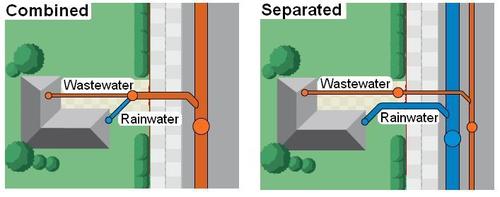(630) 682-4700
2655 Warrenville Road, Suite 225, Downers Grove, IL 60515
Better information about your collection, water, and stormwater systems
Explore ClarityBetter information about your collection, water, and stormwater systems
Explore ClaritySeparate Sewers (Part 1 of 2)

Vincent Bergl, PE, is a Senior Modeling Engineer skilled with InfoWorks, Sewer...
I recently caught up with an old college friend who mentioned she was refraining from using water during heavy rains so that she wouldn't contribute to overloading the sewer system.
It sparked an impromptu lesson on urban hydrology and after hearing similar concerns expressed elsewhere, I thought it was worth sharing my thoughts. No one welcomes beach closings or basement backups, but is abstaining from water use during storms a good way to help prevent sewer overflows? The answer is maybe sometimes, but not really, depending on context. Let me explain.
Let’s start by distinguishing separated from combined sewer systems because the difference has a lot to do with the answer. Combined systems collect both wastewater and stormwater runoff in one pipe, whereas separated sewer systems have a pipe dedicated for stormwater runoff and another for wastewater. Even in separated systems, as much as 10% of rainfall enters the wrong pipes in the form of inflow and infiltration (I/I). If you live in a community with a separated sewer system, the primary risk of an overloaded collection system is that the pipes will surcharge. This is most likely to happen during heavy rain when I/I overwhelms the system and builds pressure, forcing wastewater overflows into basements and out the tops of manholes. These surcharges are called sanitary sewer overflows (SSOs).

But can too much domestic water use also cause an SSO during dry weather? Generally, no, because sanitary sewers are designed to convey a minimum of three (and more likely, five or 10) times the peak dry-day flow. Even the smallest public sewer—an 8-inch-diameter pipe at 0.4% slope--has a full-pipe capacity of 330 gallons per minute (gpm). Putting that in perspective, the average residential household produces around 250 gallons per day (gpd) of wastewater, which equates to about 0.2 gpm. Of course, domestic water consumption isn't a constant, and the amount of wastewater produced by a single household varies greatly by source and time of day. Even at the extreme, let's say you're doing laundry and washing dishes while your spouse is taking a (probably very uncomfortable, temperature-erratic) shower, you are only kicking out 15 gpm of wastewater – roughly 5% of the capacity of that 8-inch pipe. Now, if every neighbor on your block was engaging in water-intensive tasks at that very same time, in theory, the sewer main running below your street could have some issues, but the likelihood is extremely small.
In communities with severe I/I, though, it's not uncommon for peak wet-weather flows to exceed wastewater flows by 10, 20, even 30 times. That's because I/I sources, such as deteriorated lateral connections and illegally connected downspouts, can dump more than 10 gpm into the sanitary system, dwarfing the 0.1 to 0.5 gpm average that you and your neighbors are collectively producing at any given time. While the I/I component will always be several times larger than the wastewater component in most SSO-producing events, wastewater flows representing even a twentieth of a sewer's capacity are significant enough that concerted conservation during wet weather events could lower the risk of an SSO.
While there’s no reason to eliminate water use during storm events, if you live in a community that experiences SSOs, you could be doing your neighbors a favor if you postpone laundry, bathing, and flushing. Next time we’ll explore this question for communities with combined sewers.

Vincent Bergl, PE, is a Senior Modeling Engineer skilled with InfoWorks, Sewer...